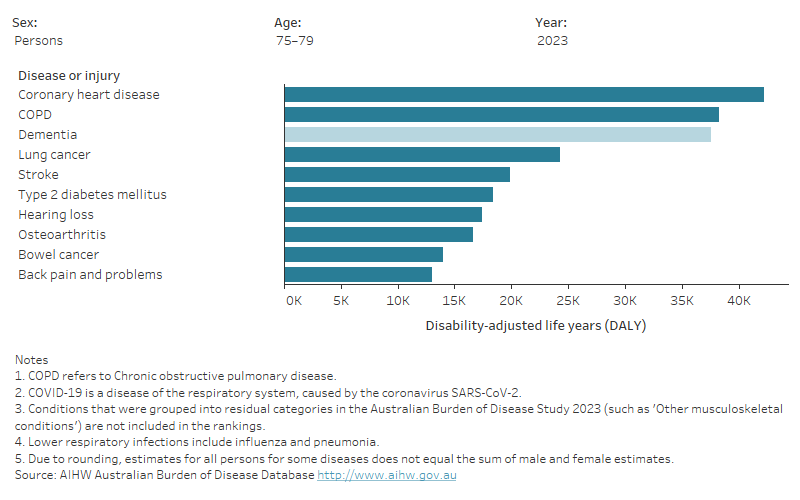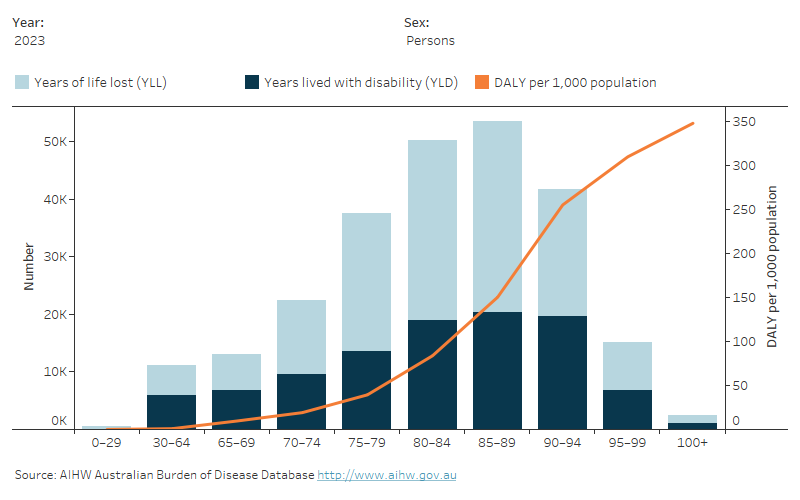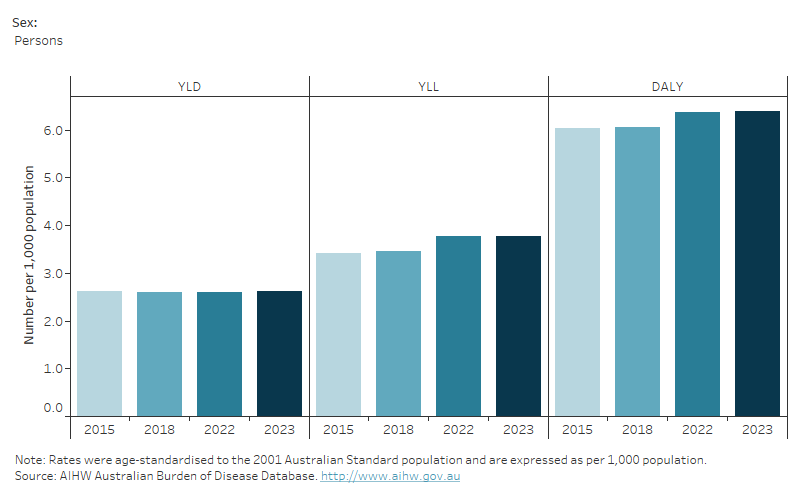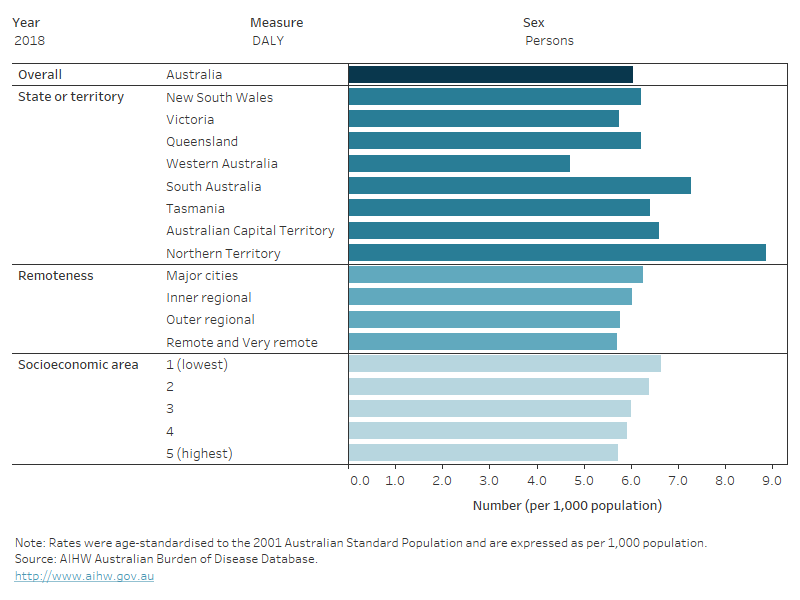Burden of disease due to dementia
Burden of disease analysis measures the combined impact of living with illness and injury (non-fatal burden) and dying prematurely (fatal burden). The fatal and non-fatal burden summed together is referred to as the total burden, measured using disability-adjusted life years (DALY). One DALY is equivalent to one year of healthy life lost. Burden of disease allows for comparisons of all diseases, illness and injury, by taking into account not only the number of people affected but the severity and duration of illness, as well as the age of people who died (AIHW 2023).
The Australian Burden of Disease Study (ABDS) 2023 provides the most up-to-date information on the burden of disease in Australia at a national level. Burden of disease estimates for the Australian population in 2023 are presented in the Australian Burden of Disease Study 2023 report.
The ABDS 2018 provides the most up-to-date information for burden of disease estimates by state and territory, remoteness and socioeconomic area, as well as estimates of disease burden attributable to risk factors (AIHW 2021). Detailed estimates from the Australian Burden of Disease Study 2018 can be found at Disease burden: interactive data and Risk factors: interactive data.
Refer to Burden of disease due to dementia among First Nations people for information based on these latest available estimates.
Refer to the Burden of disease data tables for the underlying data presented in these pages.
Dementia is a leading cause of disease burden in Australia
In 2023, dementia was the second overall leading cause of burden of disease and injury in Australia, behind coronary heart disease. Dementia was responsible for 4.4% of the total burden of disease in Australia, equivalent to around 248,000 healthy years of life lost (DALY), or 6.4 DALY per 1,000 people. Dementia was the leading cause of disease burden for females overall, 150,000 DALY of the total burden was due to dementia. In comparison, dementia was the fourth leading cause of disease burden for men (97,400 DALY).
Age is the biggest risk factor for dementia, and its ranking as a leading cause of disease burden increased as age increased. Dementia was the leading cause of burden for women as well as for all Australians aged 65 and over. This was largely due to the high disease burden among women, whereas for men dementia was only the leading cause of disease burden in 3 age groups. See Figure 4.1 for further information on the leading causes of disease by age group.
Figure 4.1: Leading 10 causes of disease burden (DALY) in Australia in 2015, 2018, 2022 and 2023: by sex and age
Figure 4.1 is a bar graph showing the leading causes of disease burden with filters for age, year and sex. For 2023 dementia is generally the leading cause of disease burden in older age groups (over 80) for all sexes.

The fatal burden, or years of life lost (YLL) is the difference between a person’s age at death, and the age at which that person would have expected to live to according to an aspirational life table. Fatal burden for dementia was calculated based on deaths where dementia was the underlying cause of death. It does not include deaths where dementia was an associated cause of death. For more information see Dying due to dementia compared to dying with dementia.
Over half (59%) of the total burden due to dementia was from dying prematurely (about 145,000 YLL). The proportion of burden due to dying prematurely was higher in males (64% or 62,000 YLL) compared with females (55% or 83,000 YLL) (Table S4.3).
Conditions that cause deaths at younger ages (such as Sudden Infant Death Syndrome) have a much higher number of YLL per death than conditions like dementia, which cause death at older ages (as there are more years of life to lose). So while the number of YLL decreases with increasing age, as there were more people dying due to dementia in the older age groups, the number of YLL due to dementia increases with increasing age. The number of disability-adjusted life years or DALY (which is the sum of the years of life lost (YLL) and years lived with disability (YLD)) was greatest between ages 80 and 94, peaking slightly younger in men (age 80–84) compared with women (age 85–89) (Figure 4.2). From age 95 onwards there was a sharp decline in the number of DALY due to a smaller population at this age. However, the rate of DALY due to dementia continued to increase with increasing age.
Figure 4.2: Dementia burden in Australia in 2015, 2018, 2022 and 2023 by sex and age: number (YLL, YLD) and age-specific rate (DALY per 1,000 people)
Figure 4.2 is a bar graph showing the number of years life lost (YLL) and year lived with disability (YLD) with a line graph over the top showing the age-standardised rate of disability-adjusted life years (DALY). The highest YLL and YLD are between the 75 to 94 years of ages for all sexes and the DALY rate increases with age peaking at the oldest age group (100+).

Burden due to dementia increased between 2015 and 2023
Dementia has risen from the third leading cause of disease burden in 2015 (behind coronary heart disease and back pain and problems) to be the second leading cause in 2023 (behind coronary heart disease).
There was a slight increase in the age-standardised rate of total burden due to dementia between 2015 and 2023, from 6.0 DALY to 6.4 DALY per 1,000 people, due to an increase in fatal burden (from 3.4 YLL to 3.8 YLL per 1,000 people) (Figure 4.3). Due to the lack of high-quality data on dementia prevalence (number of people with dementia) and associated disease severity in Australia, the same prevalence and severity rates were used to estimate the non-fatal burden due to dementia in 2015, 2018, 2022 and 2023. As such, there is no change in the YLD rates between 2015 and 2023.
Improvements in estimating dementia prevalence will assist in future calculations of the burden of disease due to dementia in Australia. For more information on the work that is being done to improve dementia prevalence estimates for Australia refer to Prevalence of dementia.
Figure 4.3: Dementia burden in Australia in 2015, 2018, 2022 and 2023, by sex: age-standardised YLL, YLD and DALY per 1,000 people
Figure 4.3 shows 3 bar graphs comparing the dementia burden across 4 different years. The YLL, YLD and DALY are similar between different years.

Dementia burden differed across population groups
The disease burden experienced in a population (both the amount and types of disease) are influenced by a number of geographic and socioeconomic factors, such as income, education, employment and access to health and social support services.
In the ABDS 2018, remoteness areas are based on an area’s relative distance to services and divided into 4 areas:
- Major cities
- Inner regional
- Outer regional
- Remote/Very remote areas.
Socioeconomic areas are presented as quintiles and based on a number of socioeconomic characteristics (such as household income, employment and education levels) of the area where a person lives. Quintile 1 represents the 20% of the population living in areas with the greatest overall level of disadvantage whereas Quintile 5 represents the 20% living in areas with the least overall level of disadvantage.
In 2018, the age-standardised DALY rate due to dementia varied by geographic and socioeconomic group (Figure 4.4):
- The Northern Territory had the highest rate of dementia burden (8.9 DALY per 1,000 people), and was much higher than the national rate (6.1 DALY per 1,000 people).
- This is likely due to a combination of factors including, the Northern Territory having a younger demographic and greater proportion of First Nations people compared with other states and territories, as well as increased prevalence of a number of known risk factors for dementia compared with other states and territories.
- Western Australia had the lowest rate of dementia burden of all the states and territories (4.7 DALY per 1,000 people).
- Major cities had the highest rate of dementia burden (6.3 DALY per 1,000 people) and Outer regional and Remote/ Very remote areas had the lowest rates (5.8 and 5.7 DALY per 1,000 people, respectively).
- People who lived in the lowest socioeconomic area (Quintile 1) had the highest rate of dementia burden (6.6 DALY per 1,000 people), and the rate of dementia burden decreased with each increasing socioeconomic quintile.
Between 2011 and 2018, changes in the rate of dementia burden varied by state. The rate declined for the Northern Territory, Tasmania and Western Australia (by between 0.5 to 1.0 DALY per 1,000 people); rose for the Australian Capital Territory, New South Wales and Queensland (by between 0.6 to 0.8 DALY per 1,000 people); and remained relatively steady for Victoria.
The rate of burden rose for all remoteness areas and by a similar amount between 2011 and 2018; whereas, it was either steady or rose only slightly for most socioeconomic areas, with the exception of the lowest socioeconomic area which increased from 5.6 to 6.6 DALY per 1,000 people.
Note, patterns in state and territory YLD rates differ to the state and territory prevalence estimate patterns shown in Prevalence of dementia. For burden of disease analyses, prevalence estimates were derived by applying the state and territory proportions of deaths due to dementia to the national prevalence estimates, and then multiplying by the associated disability weights (measure of health loss) to obtain YLD estimates for dementia.
Figure 4.4: Dementia burden in 2011, 2015 and 2018, by geographic and socioeconomic areas and sex: DALY, YLL and YLD per 1,000 people
Figure 4.4 is a bar graph showing that in 2018, dementia DALY rates were highest rates in the Northern Territory, Major cities and the lowest socioeconomic area, and were lowest in Western Australia, Outer regional and Remote/ Very remote areas and the highest socioeconomic areas. Between 2011 and 2018, dementia DALY rates decreased for the Northern Territory, Tasmania and Western Australia and increased for the Australian Capital Territory, New South Wales, and Queensland, as well as for all remoteness areas. In 2011, dementia DALY rates were similar across socioeconomic areas, but between 2011 and 2018, dementia DALY rates increased for the lowest socioeconomic areas only.

AIHW (Australian Institute of Health and Welfare) (2021) Australian Burden of Disease Study 2018: Interactive data on disease burden, AIHW, Australian Government, accessed 12 December 2022.
AIHW (2023) Australian Burden of Disease Study 2023, AIHW, Australian Government, accessed 28 February 2023.


